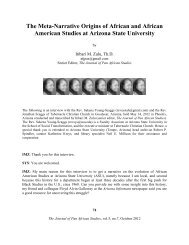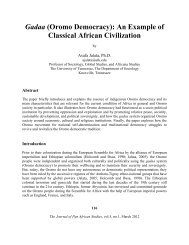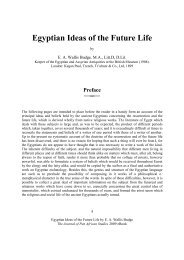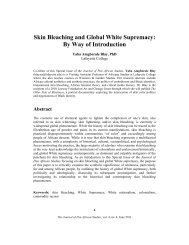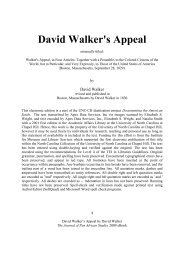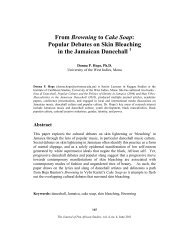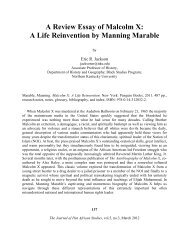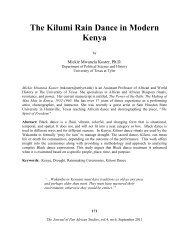Rhythms of the Gods: Music, Spirituality and Social Engagement in ...
Rhythms of the Gods: Music, Spirituality and Social Engagement in ...
Rhythms of the Gods: Music, Spirituality and Social Engagement in ...
You also want an ePaper? Increase the reach of your titles
YUMPU automatically turns print PDFs into web optimized ePapers that Google loves.
<strong>Rhythms</strong> <strong>of</strong> <strong>the</strong> <strong>Gods</strong>: <strong>Music</strong>, <strong>Spirituality</strong> <strong>and</strong><br />
<strong>Social</strong> <strong>Engagement</strong> <strong>in</strong> Yoruba Culture<br />
by<br />
Bode Omojola, Ph.D.<br />
Mount Holyoke College, South Hadley, MA<br />
Bode Omojola teaches ethnomusicology at Mount Holyoke College <strong>and</strong> <strong>the</strong> Five Colleges. His<br />
research focuses on <strong>in</strong>digenous <strong>and</strong> modern Nigerian <strong>and</strong> Yoruba musical traditions, explor<strong>in</strong>g<br />
<strong>the</strong>mes such as music <strong>and</strong> politics; music <strong>and</strong> spirituality; gender <strong>and</strong> performance; <strong>and</strong><br />
<strong>in</strong>tercultural aes<strong>the</strong>tics.<br />
Abstract<br />
The notions <strong>of</strong> “icons as objects” <strong>and</strong> “icons as act” (Kasfir, 1998: 20) are used to analyze <strong>the</strong><br />
mediatory role <strong>of</strong> Yorùbá musicians <strong>in</strong> meet<strong>in</strong>g <strong>the</strong> spiritual <strong>and</strong> <strong>the</strong> social needs <strong>of</strong> <strong>the</strong>ir<br />
communities. The author expla<strong>in</strong>s that Yoruba performers are constantly aware <strong>of</strong> <strong>the</strong> discursive<br />
engagement between àsà (social engagement <strong>and</strong> cultural practice) <strong>and</strong> èsìn (spiritual devotion),<br />
<strong>and</strong> posits that <strong>the</strong>re is a conceptual engagement between <strong>the</strong> mediat<strong>in</strong>g role <strong>of</strong> Yoruba<br />
performers <strong>and</strong> <strong>the</strong> <strong>the</strong>matic <strong>and</strong> structural features <strong>of</strong> <strong>the</strong>ir performances. This fact speaks to <strong>the</strong><br />
constant <strong>in</strong>teraction between play <strong>and</strong> spirituality as controlled by <strong>the</strong> agency <strong>of</strong> <strong>the</strong> performer,<br />
<strong>and</strong> draws attention to how Yoruba religious belief is <strong>in</strong>scribed with social significance.<br />
Introduction: Àsà <strong>and</strong> Èsìn <strong>in</strong> Yoruba Performance<br />
The constant engagement between <strong>the</strong> elements <strong>of</strong> play <strong>and</strong> spirituality <strong>in</strong> Yoruba performance<br />
provides <strong>the</strong> sett<strong>in</strong>g for underst<strong>and</strong><strong>in</strong>g <strong>the</strong> role <strong>of</strong> <strong>the</strong> Yoruba performer as a mediator between<br />
temporal <strong>and</strong> spiritual doma<strong>in</strong>s <strong>of</strong> existence. Yoruba masquerade performances are particularly<br />
illustrative <strong>of</strong> this mediatory role. The masker, usually a male, physically relates to <strong>the</strong> human<br />
audiences who follow, tease, praise, observe, <strong>and</strong> perform with him. He must however also relate<br />
to <strong>the</strong> div<strong>in</strong>e presence <strong>of</strong> <strong>the</strong> ancestral forces that he embodies. For while, on <strong>the</strong> one h<strong>and</strong>, he<br />
must deal with esoteric narratives <strong>and</strong> age-long rituals that communicate directly with deities, he<br />
must, on <strong>the</strong> o<strong>the</strong>r h<strong>and</strong>, also respond <strong>and</strong> relate to <strong>the</strong> social situations with<strong>in</strong> which religious<br />
rituals derive mean<strong>in</strong>g <strong>in</strong> real life terms.<br />
232<br />
The Journal <strong>of</strong> Pan African Studies, vol.3, no.9, June-July 2010
As a lum<strong>in</strong>al agent <strong>in</strong>habit<strong>in</strong>g <strong>the</strong> threshold <strong>of</strong> <strong>the</strong>se two spaces, <strong>the</strong> Yoruba performer connects<br />
<strong>the</strong> liv<strong>in</strong>g with <strong>the</strong> spiritual; life with death; body with soul; as well as <strong>the</strong> aes<strong>the</strong>tic with <strong>the</strong><br />
div<strong>in</strong>e. Comment<strong>in</strong>g on <strong>the</strong> <strong>in</strong>teraction between <strong>the</strong> spiritual <strong>and</strong> <strong>the</strong> social <strong>in</strong> African<br />
masquerade rituals, Kasfir (1998: 18) expla<strong>in</strong>s that “most African masquerades signify<br />
someth<strong>in</strong>g beside <strong>the</strong> basic visual <strong>and</strong> <strong>the</strong> performative act <strong>of</strong> a person <strong>in</strong> a costume play<strong>in</strong>g<br />
before an audience.” In addition to <strong>the</strong> visual <strong>and</strong> sonic experience generated “through <strong>the</strong> use <strong>of</strong><br />
some comb<strong>in</strong>ation <strong>of</strong> facial disguise, costume, body decoration, props, movement, vocalization,<br />
drumm<strong>in</strong>g,” a masquerade out<strong>in</strong>g is premised on “a structure <strong>of</strong> belief which typically associates<br />
this illusion with <strong>the</strong> embodiment <strong>of</strong> a spirit or, <strong>in</strong> certa<strong>in</strong> places, <strong>the</strong> appearance <strong>of</strong> re<strong>in</strong>carnated<br />
ancestor” (Kasfir, 1998: 18). Margaret Drewal captures <strong>the</strong> play element <strong>of</strong> Yoruba<br />
performances through her discussion <strong>of</strong> <strong>the</strong> concept <strong>of</strong> improvisation. Accord<strong>in</strong>g to her, “[w]hen<br />
Yoruba people say that <strong>the</strong>y perform ritual just like <strong>the</strong>ir ancestors did it <strong>in</strong> <strong>the</strong> past,<br />
improvisation is implicit <strong>in</strong> <strong>the</strong>ir recreation or restoration” (Drewal, 1992: 23).<br />
Yoruba performers are constantly aware <strong>of</strong> <strong>the</strong> discursive engagement between àsà (social<br />
engagement <strong>and</strong> cultural practice) <strong>and</strong> èsìn (spiritual devotion). For example, Sule Ayantunde, a<br />
Yoruba drummer with whom I worked <strong>in</strong> Nigeria <strong>and</strong> whose performances are discussed later <strong>in</strong><br />
this essay, constantly employed <strong>the</strong> two terms to describe <strong>the</strong> nature <strong>of</strong> his performances. The<br />
simultaneous employment <strong>of</strong> masks <strong>and</strong> musical <strong>in</strong>struments as objects <strong>of</strong> worship <strong>and</strong> play<br />
draws attention to <strong>the</strong> dialectical engagement between <strong>the</strong> conception <strong>of</strong> performance material as<br />
a symbol <strong>of</strong> religious belief on one h<strong>and</strong>, <strong>and</strong> <strong>the</strong> demystification <strong>of</strong> sacred performance to<br />
facilitate social <strong>in</strong>teraction <strong>and</strong> dialogue, on <strong>the</strong> o<strong>the</strong>r. References <strong>and</strong> allusions to mundane<br />
human situations even <strong>in</strong> <strong>the</strong> midst <strong>of</strong> <strong>the</strong> most serious <strong>and</strong> <strong>in</strong>tense spiritual worship are not<br />
uncommon. Performers <strong>and</strong> performances <strong>of</strong>ten constitute <strong>the</strong> medium through which <strong>the</strong><br />
boundaries between <strong>the</strong>se two spaces collapse, <strong>and</strong> <strong>the</strong> w<strong>in</strong>dow through which we may glean<br />
how <strong>the</strong> elements <strong>of</strong> play <strong>and</strong> spirituality <strong>in</strong>teract to shape religious rituals <strong>and</strong> facilitate social<br />
conversation <strong>and</strong> <strong>in</strong>teraction.<br />
The notions <strong>of</strong> “icons as objects” <strong>and</strong> “icons as act” (Kasfir, 1998: 20) can be used to analyze <strong>the</strong><br />
mediatory role <strong>of</strong> Yoruba musicians <strong>in</strong> meet<strong>in</strong>g <strong>the</strong> spiritual <strong>and</strong> <strong>the</strong> social needs <strong>of</strong> <strong>the</strong>ir<br />
communities. The <strong>in</strong>tersection <strong>of</strong> <strong>the</strong>se two modes <strong>of</strong> expression provides a framework for<br />
analyz<strong>in</strong>g how ritual <strong>and</strong> musical material are composed, re-composed, organized <strong>and</strong> performed<br />
<strong>in</strong> Yoruba culture. There is an engag<strong>in</strong>g relationship between <strong>the</strong> mediat<strong>in</strong>g role <strong>of</strong> Yoruba<br />
performers <strong>and</strong> <strong>the</strong> <strong>the</strong>matic <strong>and</strong> structural features <strong>of</strong> <strong>the</strong>ir performances. Yoruba religious ritual<br />
performance is def<strong>in</strong>ed by <strong>the</strong> constant <strong>in</strong>terplay <strong>of</strong> <strong>the</strong> elements <strong>of</strong> play <strong>and</strong> spirituality as<br />
controlled by <strong>the</strong> agency <strong>of</strong> <strong>the</strong> performer. As John <strong>and</strong> Margaret Drewal have argued <strong>in</strong> <strong>the</strong>ir<br />
discussion <strong>of</strong> gèlèdé masks, performers have “<strong>the</strong> performative power to marshal <strong>the</strong> forces <strong>in</strong><br />
<strong>the</strong> Yoruba cosmos for society’s well-be<strong>in</strong>g. It is at once spectacle <strong>and</strong> ritual. It is enterta<strong>in</strong><strong>in</strong>g<br />
<strong>and</strong> it is efficacious. But it is perceived to be more than a mode <strong>of</strong> persuasion. It is an <strong>in</strong>strument<br />
with which <strong>the</strong> “gods <strong>of</strong> society” ma<strong>in</strong>ta<strong>in</strong> social control.” (Drewal <strong>and</strong> Drewal, 1983: xvi).<br />
233<br />
The Journal <strong>of</strong> Pan African Studies, vol.3, no.9, June-July 2010
The Yoruba performer <strong>and</strong> his audience are thus constantly aware that religious experiences are<br />
mean<strong>in</strong>gful only when <strong>the</strong>y reflect <strong>and</strong> respond to <strong>the</strong> existential reality <strong>of</strong> social <strong>and</strong> cultural<br />
life. And because <strong>the</strong> ultimate purpose <strong>of</strong> Yoruba religious rituals is to give validity <strong>and</strong> mean<strong>in</strong>g<br />
to social experience <strong>and</strong> enhance <strong>the</strong> quality <strong>of</strong> life, <strong>the</strong> Yoruba performer <strong>of</strong>ten conceives <strong>the</strong><br />
expressive doma<strong>in</strong>s <strong>of</strong> song, drumm<strong>in</strong>g , dance, costume <strong>and</strong> masks as a metalanguage that<br />
connects humans <strong>and</strong> deities <strong>in</strong> <strong>the</strong> task <strong>of</strong> social eng<strong>in</strong>eer<strong>in</strong>g. The role <strong>of</strong> human agents <strong>in</strong><br />
bridg<strong>in</strong>g this gap is critical, <strong>and</strong> relies on <strong>the</strong> efficient manipulation <strong>of</strong> <strong>the</strong> tools <strong>of</strong> worship: <strong>the</strong><br />
effective use <strong>of</strong> <strong>the</strong> mask, <strong>the</strong> drum, <strong>the</strong> human body <strong>and</strong> <strong>the</strong> voice, to mention just a few, is<br />
dependent on <strong>the</strong> agency <strong>of</strong> maskers, drummers, dancers <strong>and</strong> s<strong>in</strong>gers.<br />
The ensu<strong>in</strong>g discussion derives from many years <strong>of</strong> observ<strong>in</strong>g <strong>and</strong> participat<strong>in</strong>g <strong>in</strong> specific<br />
Yoruba religious ceremonies, <strong>and</strong> from a series <strong>of</strong> field research conducted <strong>in</strong> Western Nigeria<br />
(Yoruba l<strong>and</strong>) between 1990 <strong>and</strong> 2007. In addition to analyz<strong>in</strong>g two sacred drummed texts, I<br />
provide brief ethnographic accounts <strong>of</strong> two ritual performances--òshun <strong>and</strong> egúngún festivals--as<br />
enacted <strong>in</strong> <strong>the</strong> Yoruba town <strong>of</strong> Oshogbo <strong>in</strong> 2007. The ethnographic descriptions are conceived to<br />
facilitate an underst<strong>and</strong><strong>in</strong>g <strong>of</strong> how Yoruba ritual performance resonates with social <strong>and</strong> spiritual<br />
significance. The two drummed texts that I analyze were performed by a group <strong>of</strong> Oshogbo<br />
drummers under <strong>the</strong> leadership <strong>of</strong> Sule Ayantunde, a master drummer, <strong>in</strong> Oshogbo <strong>in</strong> 2007. As a<br />
prelude to my discussion, it is <strong>in</strong>structive to briefly describe <strong>the</strong> nature <strong>of</strong> Yoruba religious<br />
belief.<br />
Yoruba God (Olódùmarè) <strong>and</strong> His Deities (Òrìsà)<br />
Ancestral spirits, deities <strong>and</strong> Olódùmarè (supreme ruler) represent key agents with<strong>in</strong> <strong>the</strong> Yoruba<br />
belief system. Yoruba deities (Òrìsà) are numerous, number<strong>in</strong>g over a thous<strong>and</strong>. i As Alana<br />
(2004: 69) expla<strong>in</strong>s, Yoruba deities fall under three categories, namely primordial deities who<br />
have existed s<strong>in</strong>ce <strong>the</strong> time <strong>of</strong> creation; deified ancestors; <strong>and</strong> deities that are associated with<br />
natural objects like rivers <strong>and</strong> hills. Primordial ones <strong>in</strong>clude Òrúnmìnlà, <strong>the</strong> deity <strong>of</strong> knowledge<br />
<strong>and</strong> div<strong>in</strong>ation, <strong>and</strong> Èsù, <strong>the</strong> unpredictable deity <strong>of</strong> human conduct who can be both malevolent<br />
<strong>and</strong> benevolent, <strong>and</strong> who reports back to Olódùmarè on matters relat<strong>in</strong>g to human activities.<br />
Examples <strong>of</strong> deities <strong>in</strong> <strong>the</strong> second category are Sàngó, <strong>the</strong> deity <strong>of</strong> thunder <strong>and</strong> lightn<strong>in</strong>g, <strong>and</strong><br />
Ògún <strong>the</strong> deity <strong>of</strong> war, metallurgy, vengeance <strong>and</strong> justice. In <strong>the</strong> third category are deities like<br />
Oya, <strong>the</strong> female deity <strong>of</strong> <strong>the</strong> River Niger, <strong>and</strong> Òkèbàdàn, which is associated with a sacred hill <strong>in</strong><br />
<strong>the</strong> city <strong>of</strong> Ibadan. All deities, no matter <strong>the</strong>ir status with<strong>in</strong> <strong>the</strong> hierarchy, are answerable<br />
ultimately to Olódùmarè, <strong>the</strong> supreme ruler <strong>of</strong> heaven <strong>and</strong> earth. <strong>Music</strong> plays a critical role <strong>in</strong><br />
def<strong>in</strong><strong>in</strong>g <strong>the</strong> personality <strong>of</strong> many <strong>of</strong> <strong>the</strong>se deities as I expla<strong>in</strong> later.<br />
234<br />
The Journal <strong>of</strong> Pan African Studies, vol.3, no.9, June-July 2010
Ensemble Sounds as Sacred Voices<br />
Of <strong>the</strong> different forms <strong>of</strong> Yoruba music (drumm<strong>in</strong>g, song, chant <strong>and</strong> dance), drumm<strong>in</strong>g is <strong>the</strong> one<br />
imbued with <strong>the</strong> greatest spiritual significance. Drum ensembles are generally <strong>of</strong> two ma<strong>in</strong><br />
categories-sacred <strong>and</strong> social. Yoruba sacred ensembles <strong>in</strong>clude s<strong>in</strong>gle-headed membrane drums<br />
like ìgbìn, ìpèsè, <strong>and</strong> ògìdán, each <strong>of</strong> which is associated with a specific deity (Euba, 1990: 93).<br />
This is because “appropriate drums must be used for particular Òrìsà; o<strong>the</strong>rwise <strong>the</strong>y [<strong>the</strong><br />
devotees] will <strong>in</strong>cur <strong>the</strong> wrath <strong>of</strong> <strong>the</strong>ir tutelary deity” (Adegbite, 1988: 16). Ìgbìn, for example, is<br />
associated with Obàtálá, <strong>the</strong> arch-div<strong>in</strong>ity <strong>and</strong> deity <strong>of</strong> children; while ipese is performed <strong>in</strong><br />
ritual activities devoted to Òrúnmìnlà. Ògìdán drums are performed to appease <strong>and</strong> venerate<br />
Ògún, while bàtá is <strong>the</strong> pr<strong>in</strong>cipal musical <strong>in</strong>strument <strong>of</strong> Sàngó worship. ii<br />
The dùndún hourglass drum, which orig<strong>in</strong>ally was regarded primarily as a social ensemble, now<br />
also functions with<strong>in</strong> religious rituals. Unlike o<strong>the</strong>r Yoruba drums, this drum consists <strong>of</strong> lea<strong>the</strong>r<br />
str<strong>in</strong>gs, which connect its two drum heads <strong>and</strong> are pulled or relaxed to alter <strong>the</strong> surface tension <strong>of</strong><br />
<strong>the</strong> drum head, thus enabl<strong>in</strong>g <strong>the</strong> drummer to generate different pitches <strong>and</strong> imitate <strong>the</strong> tonal<br />
patterns <strong>of</strong> Yoruba language. Although Yoruba drums are dom<strong>in</strong>ated by those made from a<br />
s<strong>in</strong>gle, hollowed <strong>and</strong> carved tree log, o<strong>the</strong>r examples <strong>in</strong>clude those made from gourds (such as<br />
kìrìbótó), <strong>and</strong> from ear<strong>the</strong>nware (such as àpíntì).<br />
The social <strong>and</strong> religious functions <strong>of</strong> Yoruba musical <strong>in</strong>struments <strong>of</strong>ten change over time. Two<br />
drum types, bàtá <strong>and</strong> dùndún, whose roles <strong>and</strong> functions have changed <strong>in</strong> recent times provide<br />
<strong>in</strong>terest<strong>in</strong>g perspectives on <strong>the</strong> ways <strong>in</strong> which <strong>the</strong> sacred <strong>and</strong> <strong>the</strong> secular have cont<strong>in</strong>ued to merge<br />
<strong>in</strong> Yoruba performances. Bàtá, orig<strong>in</strong>ally a sacred <strong>in</strong>strument, is now also performed <strong>in</strong> social<br />
contexts. Likewise, dùndún, because <strong>of</strong> its ability to “talk” eloquently, is now commonly<br />
employed <strong>in</strong> sacred contexts that were orig<strong>in</strong>ally associated exclusively with drums like bàtá <strong>and</strong><br />
ìgbìn. This is <strong>in</strong> addition to its cont<strong>in</strong>uous dom<strong>in</strong>ation <strong>of</strong> social performances.<br />
The association <strong>of</strong> <strong>in</strong>strumental ensembles with specific deities <strong>and</strong> religious activities illustrates<br />
<strong>the</strong> centrality <strong>of</strong> music to Yoruba religious worship. As tools <strong>of</strong> worship, some musical<br />
<strong>in</strong>struments <strong>and</strong> <strong>the</strong>ir sounds are culturally regarded as icons <strong>of</strong> specific religious cults. Indeed<br />
many ensembles derive <strong>the</strong>ir sole significance with<strong>in</strong> <strong>the</strong> context <strong>of</strong> sacred rites with which <strong>the</strong>y<br />
are associated. As Adegbite (1988:16) has observed, for example, drums like <strong>the</strong> cyl<strong>in</strong>drical<br />
àgbà-obalùfòn <strong>and</strong> ìpèsè are performed only very occasionally, sometimes just once <strong>in</strong> a year<br />
<strong>and</strong> at specific annual festivals. Such sacred drums are rarely used <strong>in</strong> o<strong>the</strong>r contexts <strong>and</strong> are kept<br />
<strong>in</strong> sacred groves.<br />
235<br />
The Journal <strong>of</strong> Pan African Studies, vol.3, no.9, June-July 2010
Cook<strong>in</strong>g <strong>the</strong> Drum: Àyànàgalú-<strong>the</strong> Deity <strong>of</strong> Yoruba Drumm<strong>in</strong>g<br />
It is generally believed that <strong>the</strong> first Yoruba drummer was a man named Àyànàgalú (see Euba,<br />
1990: 90). It is for this reason that members <strong>of</strong> Yoruba drumm<strong>in</strong>g families bear names that beg<strong>in</strong><br />
with Àyàn, a prefix <strong>of</strong> Àyànàgalú. Examples <strong>of</strong> such names are Àyántúndé (Àyàn returns),<br />
Àyánlékè (Àyàn is victorious) <strong>and</strong> Àyányemí (Àyàn is good for me). But <strong>the</strong> significance <strong>of</strong><br />
Ayangalu goes beyond its role as a means <strong>of</strong> solidify<strong>in</strong>g ancestral <strong>and</strong> vocational identity.<br />
Àyànàgalú is also regarded as <strong>the</strong> deity spirit <strong>of</strong> <strong>the</strong> drum <strong>and</strong> a guardian spirit for all drummers<br />
(Euba, 1990: 90). The spiritual force <strong>of</strong> Àyànàgalú is <strong>of</strong>ten symbolically represented on<br />
<strong>in</strong>dividual drums. In <strong>the</strong> dùndún ensemble, for example, <strong>the</strong> gúdúgúdú, <strong>the</strong> only member <strong>of</strong> <strong>the</strong><br />
ensemble with a pot-like shape, is regarded as <strong>the</strong> sacred symbol <strong>of</strong> <strong>the</strong> spirit <strong>of</strong> Àyànàgalú. The<br />
ìda <strong>and</strong> <strong>the</strong> kúsanrín, two important parts <strong>of</strong> gúdúgúdú, are imbued with <strong>the</strong> spiritual power <strong>of</strong><br />
Àyànàgalú. kúsanrín is a circular metallic object at <strong>the</strong> base <strong>of</strong> <strong>the</strong> <strong>in</strong>strument, while ìda is a<br />
paste made from a tree sap <strong>and</strong> affixed to <strong>the</strong> center <strong>of</strong> <strong>the</strong> drum head. kúsanrín <strong>and</strong> ìda are<br />
believed to be emblematic <strong>of</strong> <strong>the</strong> sacredness <strong>of</strong> <strong>the</strong> gúdúgúdú, sett<strong>in</strong>g it apart from <strong>the</strong> rema<strong>in</strong><strong>in</strong>g<br />
members <strong>of</strong> <strong>the</strong> dùndún ensemble.<br />
It is <strong>in</strong>terest<strong>in</strong>g to note that ìda <strong>and</strong> kúsanrín also serve purely acoustic functions. kúsanrín, for<br />
example, provides an anchor for <strong>the</strong> series <strong>of</strong> lea<strong>the</strong>r str<strong>in</strong>gs that help to hold <strong>the</strong> membrane <strong>of</strong><br />
<strong>the</strong> drum firmly. kúsanrín also helps to hold <strong>in</strong> place a series <strong>of</strong> wooden pegs that are placed<br />
between it <strong>and</strong> <strong>the</strong> base <strong>of</strong> <strong>the</strong> hollowed wood body, help<strong>in</strong>g to facilitate greater resonance. In <strong>the</strong><br />
same ve<strong>in</strong>, <strong>the</strong> position<strong>in</strong>g <strong>of</strong> ìda right at <strong>the</strong> center <strong>of</strong> <strong>the</strong> drum membrane is a device to partition<br />
<strong>the</strong> drum head <strong>in</strong>to a couple <strong>of</strong> pitch areas. The characteristic two-tone melo-rhythm <strong>of</strong><br />
gúdúgúdú is made possible by this partition<strong>in</strong>g. All <strong>the</strong> drummers that I discussed with <strong>in</strong> Ila-<br />
Orangun, Oshogbo, Ikirun <strong>and</strong> Ibadan were aware <strong>of</strong> <strong>the</strong> sacred <strong>and</strong> acoustic functions <strong>of</strong><br />
kúsanrín <strong>and</strong> ìda.<br />
The complementary relationship between acoustic <strong>and</strong> spiritual functions as represented <strong>in</strong> <strong>the</strong>se<br />
two elements sem<strong>in</strong>ally illustrates <strong>the</strong> <strong>in</strong>terface <strong>of</strong> play <strong>and</strong> spirituality <strong>in</strong> <strong>the</strong> organization <strong>of</strong><br />
many Yoruba ensembles, <strong>and</strong> mirrors <strong>the</strong> <strong>in</strong>tersection <strong>of</strong> <strong>the</strong> physical <strong>and</strong> <strong>the</strong> spiritual <strong>in</strong> Yoruba<br />
cosmology. The awareness <strong>of</strong> this duality by Yoruba musicians shows that <strong>the</strong>y are conscious <strong>of</strong><br />
<strong>the</strong>ir roles as performers <strong>and</strong> mediators who reconcile <strong>the</strong> social <strong>and</strong> spiritual needs <strong>of</strong> <strong>the</strong>ir<br />
community.<br />
Construct<strong>in</strong>g a drum <strong>in</strong>volves <strong>the</strong> enactment <strong>of</strong> rituals that are designed to appease Àyànàgalú,<br />
<strong>and</strong> activate <strong>the</strong> spirits that are believed to reside <strong>in</strong> <strong>the</strong> trees from which drums are made <strong>in</strong>to<br />
“talk<strong>in</strong>g” eloquently. Such trees must grow by <strong>the</strong> road side <strong>and</strong> thus conversant with human<br />
conversation. The physical process <strong>of</strong> mak<strong>in</strong>g a drum <strong>and</strong> <strong>the</strong> attendant rituals are referred to as<br />
ìlù sísè (<strong>the</strong> cook<strong>in</strong>g <strong>of</strong> <strong>the</strong> drum). Items <strong>of</strong> appeasement used <strong>in</strong> this process <strong>in</strong>clude pieces <strong>of</strong><br />
kola-nut, which are broken, prayed over <strong>and</strong> eaten; <strong>and</strong> local dry g<strong>in</strong>, which is poured as libation<br />
on <strong>the</strong> ground <strong>and</strong> on <strong>the</strong> wooden frame <strong>of</strong> <strong>the</strong> drum.<br />
236<br />
The Journal <strong>of</strong> Pan African Studies, vol.3, no.9, June-July 2010
The drum maker, usually <strong>the</strong> drummer himself, would pray to Àyànàgalú to grant his drum <strong>of</strong>ò<br />
(potent speech-utterance), <strong>and</strong> protect him from <strong>the</strong> attack <strong>of</strong> known <strong>and</strong> anonymous enemies.<br />
The focus on <strong>the</strong> element <strong>of</strong> speech <strong>and</strong> utterance highlights <strong>the</strong> emphasis on <strong>the</strong> verbal <strong>and</strong><br />
spiritual orientation <strong>of</strong> musical communication.<br />
Drummers also appease <strong>the</strong> spirit <strong>of</strong> Àyànàgalú before any major performance. This practice was<br />
enacted on many occasions dur<strong>in</strong>g my field research. At Ibadan, for example, Musibau, a bata<br />
drummer that I have worked with for many years, <strong>in</strong>sisted on pour<strong>in</strong>g libation <strong>and</strong> pray<strong>in</strong>g to <strong>the</strong><br />
spirit <strong>of</strong> Àyànàgalú before perform<strong>in</strong>g <strong>and</strong> talk<strong>in</strong>g about his drums. Right <strong>in</strong> my presence,<br />
Musibau opened <strong>the</strong> bottle <strong>of</strong> <strong>the</strong> dry g<strong>in</strong> that I had been told to br<strong>in</strong>g, poured a few drops <strong>of</strong> <strong>the</strong><br />
g<strong>in</strong> on <strong>the</strong> drum, took a number <strong>of</strong> sips <strong>and</strong> splashed <strong>the</strong> g<strong>in</strong> from his mouth to <strong>the</strong> drums. This<br />
little ritual was performed to pray <strong>and</strong> pay homage to Àyànàgalú, <strong>and</strong> as a form <strong>of</strong> spiritual<br />
cleans<strong>in</strong>g. The <strong>in</strong>terface <strong>of</strong> social engagement <strong>and</strong> spirituality is however most vividly illustrated<br />
with<strong>in</strong> <strong>the</strong> context <strong>of</strong> ritual performances. I shall now briefly discuss two examples, egúngún<br />
out<strong>in</strong>g <strong>and</strong> Òsun festival, as enacted <strong>in</strong> Oshogbo <strong>in</strong> August 2007.<br />
Yoruba Ritual Performance: Two Ethnographic Accounts<br />
a. An Egúngún Performance <strong>in</strong> Oshogbo<br />
On July 15, 2007, I watched a public “out<strong>in</strong>g” (ìjáde) <strong>of</strong> lábúàtà, a masquerade <strong>in</strong> Oshogbo,<br />
Western Nigeria. Lábúàtà is a family masquerade (eégún ìdílé) <strong>of</strong> <strong>the</strong> Adegoke family <strong>of</strong> Isale<br />
Oshun, Oshogbo. The July 15, 2007 “out<strong>in</strong>g” was <strong>the</strong> first <strong>of</strong> its three performances for <strong>the</strong> year,<br />
<strong>and</strong> was devoted largely to pay<strong>in</strong>g homage to <strong>the</strong> Ataoja, <strong>the</strong> k<strong>in</strong>g <strong>of</strong> Oshogbo. In spite <strong>of</strong> its<br />
status as a family event, lábúàtà’s ìjáde is witnessed by a large segment <strong>of</strong> <strong>the</strong> general public,<br />
<strong>and</strong> enjoys <strong>the</strong> special bless<strong>in</strong>g <strong>and</strong> <strong>in</strong>terest <strong>of</strong> <strong>the</strong> Ataoja. iii Lábúàtà’s out<strong>in</strong>g is m<strong>and</strong>atorily<br />
accompanied by a bàtá ensemble. In 2007, <strong>the</strong> ensemble consisted <strong>of</strong> a large number <strong>of</strong><br />
support<strong>in</strong>g drummers play<strong>in</strong>g <strong>the</strong> omele abo, omele ako <strong>and</strong> omele kúdí; iv <strong>and</strong> two master<br />
drummers who alternated on <strong>the</strong> ìyáàlu bàtá, <strong>the</strong> lead<strong>in</strong>g drum. Given <strong>the</strong> rigorous nature <strong>of</strong><br />
play<strong>in</strong>g ìyáàlu bàtá <strong>and</strong> <strong>the</strong> extended nature <strong>of</strong> this particular ritual <strong>and</strong> musical event, it would<br />
have been too challeng<strong>in</strong>g for a s<strong>in</strong>gle drummer to lead <strong>the</strong> ensemble for <strong>the</strong> entire performance.<br />
The larger <strong>of</strong> <strong>the</strong> two drum heads <strong>of</strong> ìyáàlu bàtá <strong>and</strong> omele abo is known as ojú òjò. Ojú òjò is<br />
usually played with <strong>the</strong> palm <strong>of</strong> <strong>the</strong> right h<strong>and</strong>, while <strong>the</strong> smaller drum head (sásá) is played with<br />
<strong>the</strong> left h<strong>and</strong> us<strong>in</strong>g a rubber or lea<strong>the</strong>r beater. Omele ako <strong>and</strong> omele kúdi are usually tied toge<strong>the</strong>r<br />
<strong>and</strong> played by a s<strong>in</strong>gle drummer. In 2007, two additional omele ako <strong>and</strong> omele kúdi were used<br />
for <strong>the</strong> event because <strong>of</strong> <strong>the</strong> relatively large number <strong>of</strong> participants. A description <strong>of</strong> <strong>the</strong> event<br />
now follows.<br />
237<br />
The Journal <strong>of</strong> Pan African Studies, vol.3, no.9, June-July 2010
On <strong>the</strong> day <strong>of</strong> <strong>the</strong> out<strong>in</strong>g <strong>of</strong> lábúàtà, family members from far <strong>and</strong> near ga<strong>the</strong>r <strong>in</strong> <strong>the</strong> family<br />
compound toge<strong>the</strong>r with friends <strong>and</strong> neighbors. At about NOON, <strong>the</strong> masquerade emerges from<br />
its chamber, a room <strong>in</strong>side <strong>the</strong> family house, <strong>and</strong> is immediately heralded by <strong>the</strong> sounds <strong>of</strong> bata<br />
drums. Lábúàtà’s attire is a large tattered look<strong>in</strong>g garment whose backside consists <strong>of</strong> a dry,<br />
unshaven animal sk<strong>in</strong>-lea<strong>the</strong>r that hangs from <strong>the</strong> neck area down to <strong>the</strong> feet. Lábúàtà’s face<br />
mask is a carved wood consist<strong>in</strong>g <strong>of</strong> three undulations at <strong>the</strong> top, each <strong>of</strong> which represents <strong>the</strong><br />
three children (two sons <strong>and</strong> a daughter) <strong>of</strong> <strong>the</strong> Adegoke family.<br />
Lábúàtà <strong>and</strong> members <strong>of</strong> <strong>the</strong> Adegoke family spend about twenty m<strong>in</strong>utes by a small tree right <strong>in</strong><br />
front <strong>of</strong> <strong>the</strong> house, engaged <strong>in</strong> a sacred <strong>and</strong> private ritual. They pray for <strong>the</strong> family <strong>and</strong> pour<br />
libation <strong>in</strong> honor <strong>of</strong> departed members. Lábúàtà <strong>the</strong>reafter visits neighbor<strong>in</strong>g houses before<br />
lead<strong>in</strong>g a procession to <strong>the</strong> k<strong>in</strong>g’s palace, about a kilometer away. We move toge<strong>the</strong>r to <strong>the</strong><br />
palace, where a large crowd <strong>of</strong> people had ga<strong>the</strong>red to await lábúàtà’s arrival. The music <strong>of</strong> <strong>the</strong><br />
procession comprises <strong>of</strong> female s<strong>in</strong>gers chant<strong>in</strong>g family epi<strong>the</strong>ts to <strong>the</strong> accompaniment <strong>of</strong> bàtá<br />
drumm<strong>in</strong>g.<br />
The performance at <strong>the</strong> k<strong>in</strong>g's palace lasts for about 90 m<strong>in</strong>utes. The k<strong>in</strong>g <strong>and</strong> some <strong>of</strong> his chiefs<br />
emerge from <strong>in</strong>side <strong>the</strong> old palace <strong>and</strong> sit <strong>in</strong> <strong>the</strong> porch, periodically acknowledg<strong>in</strong>g salutations<br />
from town folks. The masquerade does not move close to <strong>the</strong> k<strong>in</strong>g because it is a taboo for <strong>the</strong><br />
k<strong>in</strong>g to see <strong>the</strong> body <strong>of</strong> a dead person or its representation <strong>in</strong> form <strong>of</strong> a masquerade. The crowd<br />
forms two parallel rows, demarcat<strong>in</strong>g an arena <strong>and</strong> a passage from <strong>the</strong> masquerade party to <strong>the</strong><br />
ver<strong>and</strong>a <strong>of</strong> <strong>the</strong> Ataoja. Some <strong>of</strong> <strong>the</strong> pilots <strong>of</strong> <strong>the</strong> egúngún move <strong>in</strong> turns to pay homage to <strong>the</strong><br />
k<strong>in</strong>g, while <strong>the</strong> k<strong>in</strong>g's err<strong>and</strong> person moves back <strong>and</strong> forth between <strong>the</strong> k<strong>in</strong>g’s party <strong>and</strong> that <strong>of</strong><br />
<strong>the</strong> masquerade to deliver monetary gifts from <strong>the</strong> k<strong>in</strong>g <strong>and</strong> his chiefs to <strong>the</strong> masquerade, <strong>the</strong><br />
drummers <strong>and</strong> <strong>the</strong> women chanters who cont<strong>in</strong>ue to embellish <strong>the</strong> performance with <strong>the</strong>ir<br />
sonorous voices. v<br />
The performance <strong>in</strong>volv<strong>in</strong>g lábúàtà, drummers, chanters <strong>and</strong> <strong>the</strong> participat<strong>in</strong>g audience at <strong>the</strong><br />
k<strong>in</strong>g’s palace illustrates how musical enterta<strong>in</strong>ment is provided with<strong>in</strong> <strong>the</strong> context <strong>of</strong> a Yoruba<br />
religious event. Although <strong>the</strong> entire event is conceived as a form <strong>of</strong> ancestral veneration, <strong>and</strong><br />
although <strong>the</strong> open<strong>in</strong>g part <strong>of</strong> <strong>the</strong> event is a private <strong>of</strong>fer<strong>in</strong>g to ancestral spirits, <strong>the</strong> procession<br />
through <strong>the</strong> town <strong>and</strong> <strong>the</strong> display at <strong>the</strong> k<strong>in</strong>g’s palace represent a public performance <strong>in</strong> which<br />
lábúàtà <strong>in</strong>teracts <strong>and</strong> performs with <strong>the</strong> crowd around him. The arena <strong>of</strong> performance is dynamic<br />
<strong>and</strong> <strong>in</strong>teractive as audience members s<strong>in</strong>g <strong>and</strong> tease <strong>the</strong> ferocious masquerade.<br />
238<br />
The Journal <strong>of</strong> Pan African Studies, vol.3, no.9, June-July 2010
. Òshun Festival <strong>in</strong> Oshogbo<br />
Òshun festival is held annually <strong>in</strong> <strong>the</strong> town <strong>of</strong> Oshogbo as <strong>in</strong> many o<strong>the</strong>r Yoruba communities <strong>in</strong><br />
Nigeria. vi Òshun is <strong>the</strong> focus <strong>of</strong> elaborate religious activities amongst Yoruba communities<br />
with<strong>in</strong> Nigeria <strong>and</strong> outside, <strong>in</strong> countries like Ben<strong>in</strong>, Brazil, Cuba <strong>and</strong> <strong>the</strong> United States. My<br />
discussion here however concentrates on Òshun Oshogbo (Òshun festival <strong>of</strong> Oshogbo), which is<br />
<strong>the</strong> most spectacular <strong>of</strong> Òshun festivals anywhere <strong>in</strong> <strong>the</strong> world. Although a religious event to<br />
appease <strong>and</strong> venerate Òshun (a Yoruba female deity believed to have <strong>the</strong> power to heal, give<br />
children, grant wealth <strong>and</strong> protect), <strong>the</strong> festival also provides <strong>the</strong> forum for <strong>the</strong> community to<br />
renew <strong>the</strong>ir allegiance to <strong>the</strong> k<strong>in</strong>g <strong>and</strong> affirm a sense <strong>of</strong> group solidarity. In recent years <strong>the</strong><br />
festival has also become a political event at which politicians promote <strong>the</strong>ir <strong>in</strong>terests. The f<strong>in</strong>al<br />
day <strong>of</strong> <strong>the</strong> festival (ojó Òshun) comes after days <strong>of</strong> rituals, many <strong>of</strong> which are restricted to a<br />
limited set <strong>of</strong> people. The first <strong>of</strong> <strong>the</strong>se is known as ìwópópó (street cleans<strong>in</strong>g procession)<br />
performed to spiritually cleanse <strong>the</strong> town. Ìwópópó marks <strong>the</strong> <strong>of</strong>ficial commencement <strong>of</strong> series <strong>of</strong><br />
events culm<strong>in</strong>at<strong>in</strong>g <strong>in</strong> ojó Òshun.<br />
Many <strong>of</strong> <strong>the</strong> rituals event lead<strong>in</strong>g up to ojó Òshun are designed to acknowledge <strong>the</strong> importance<br />
<strong>of</strong> o<strong>the</strong>r prom<strong>in</strong>ent Yoruba deities, although <strong>the</strong> festival itself is dedicated largely to Òshun. On<br />
<strong>the</strong> fourth day, for example, <strong>the</strong> appearance <strong>of</strong> masquerades serves to venerate Sàngó. The ritual<br />
lighten<strong>in</strong>g <strong>of</strong> a 16-burner lamp (àtùpà olójúmérìndínlógún) on <strong>the</strong> sixth night is also <strong>of</strong> great<br />
spiritual importance. Dur<strong>in</strong>g this ritual, <strong>the</strong> k<strong>in</strong>g <strong>and</strong> members <strong>of</strong> his family dance round <strong>the</strong><br />
lamp three times before dawn. This ritual event is performed to venerate Òsanyìn, <strong>the</strong> Yoruba<br />
deity <strong>of</strong> herbal medic<strong>in</strong>e. On <strong>the</strong> seventh day, ifá (div<strong>in</strong>ation) rites are held, while <strong>the</strong> eighth day<br />
is dedicated to honor<strong>in</strong>g Oya, <strong>the</strong> deity <strong>of</strong> <strong>the</strong> River Niger. Also celebrated on <strong>the</strong> eighth day is<br />
Orò, <strong>the</strong> deity <strong>of</strong> <strong>the</strong> w<strong>in</strong>d.<br />
Ojó Òshun, <strong>the</strong> n<strong>in</strong>th <strong>and</strong> f<strong>in</strong>al day <strong>of</strong> <strong>the</strong> festival, is dedicated to Òshun. For many people, this<br />
gr<strong>and</strong> f<strong>in</strong>ale is <strong>the</strong> real Òshun festival. On this day, a votary maid (arugbá), a virg<strong>in</strong> girl selected<br />
from <strong>the</strong> royal family through div<strong>in</strong>ation, carries a calabash conta<strong>in</strong><strong>in</strong>g items <strong>of</strong> sacrifice from<br />
<strong>the</strong> k<strong>in</strong>g’s palace to Òshun grove, <strong>the</strong> venue <strong>of</strong> <strong>the</strong> festival. Arugbá’s possession to <strong>the</strong> grove<br />
also features <strong>the</strong> chief priestess, <strong>the</strong> k<strong>in</strong>g <strong>and</strong> his household, chiefs, <strong>and</strong> members <strong>of</strong> Oshogbo<br />
community amidst drumm<strong>in</strong>g <strong>and</strong> s<strong>in</strong>g<strong>in</strong>g. vii On arrival at <strong>the</strong> grove, arugbá is greeted by<br />
thous<strong>and</strong>s <strong>of</strong> participants <strong>and</strong> visitors who had been wait<strong>in</strong>g for her to come. She later retries to<br />
Òshun shr<strong>in</strong>e, located with<strong>in</strong> <strong>the</strong> grove. The k<strong>in</strong>g later addresses <strong>the</strong> people after which he<br />
proceeds to <strong>the</strong> shr<strong>in</strong>e to pray. Arugbá, <strong>the</strong> chief priestess <strong>and</strong> <strong>the</strong> k<strong>in</strong>g later return to <strong>the</strong> palace,<br />
mark<strong>in</strong>g <strong>the</strong> <strong>of</strong>ficial end to <strong>the</strong> sacred part <strong>of</strong> <strong>the</strong> festival. Powerful drumm<strong>in</strong>g, exuberant danc<strong>in</strong>g<br />
<strong>and</strong> s<strong>in</strong>g<strong>in</strong>g cont<strong>in</strong>ue throughout <strong>the</strong> festival.<br />
239<br />
The Journal <strong>of</strong> Pan African Studies, vol.3, no.9, June-July 2010
These two ethnographic accounts highlight important features <strong>of</strong> Yoruba ritual performance. In<br />
both cases, musical <strong>in</strong>struments function as tools <strong>of</strong> worship <strong>and</strong> as icons <strong>of</strong> transcendental<br />
powers. In <strong>the</strong> egúngún performance, bàtá drums function as a symbolic representation <strong>of</strong> <strong>the</strong><br />
spiritual significance <strong>of</strong> lábúàtà. But <strong>the</strong> drum ensemble is also a major component <strong>of</strong> an<br />
enterta<strong>in</strong><strong>in</strong>g musical performance through which <strong>the</strong> masquerade relates to his immediate<br />
physical <strong>and</strong> social environment. The masquerade, <strong>in</strong> spite <strong>of</strong> <strong>the</strong> burden that he carries<br />
physically (<strong>the</strong> heavy attire <strong>and</strong> <strong>the</strong> mask that he wears) <strong>and</strong> spiritually (his exalted state <strong>of</strong> m<strong>in</strong>d<br />
as facilitated by days <strong>of</strong> pray<strong>in</strong>g <strong>and</strong> fast<strong>in</strong>g prior to his out<strong>in</strong>g), responds sporadically to <strong>the</strong><br />
music, generat<strong>in</strong>g cheers from <strong>the</strong> audience. The procession <strong>of</strong> <strong>the</strong> masquerade to <strong>the</strong> k<strong>in</strong>g’s<br />
palace <strong>and</strong> <strong>the</strong> demarcation <strong>of</strong> <strong>the</strong> space between <strong>the</strong> masquerade party <strong>and</strong> <strong>the</strong> royal dignitaries<br />
also illustrate <strong>the</strong> ways <strong>in</strong> which spiritual power is reconciled with political authority. <strong>Music</strong>al<br />
performance on bàtá drums helps to bridge <strong>the</strong> gap between political <strong>and</strong> spiritual powers, while<br />
facilitat<strong>in</strong>g a triangular <strong>in</strong>teraction between spiritual power, royal authority, <strong>and</strong> <strong>the</strong> ord<strong>in</strong>ary<br />
citizens <strong>of</strong> <strong>the</strong> community.<br />
In <strong>the</strong> Òshun event, dùndún music helps to navigate <strong>the</strong> various “journeys” that take place dur<strong>in</strong>g<br />
<strong>the</strong> festival. These <strong>in</strong>clude <strong>the</strong> procession <strong>of</strong> <strong>the</strong> votary maid to <strong>and</strong> with<strong>in</strong> <strong>the</strong> grove; <strong>and</strong> <strong>the</strong><br />
movements <strong>of</strong> <strong>the</strong> k<strong>in</strong>g between <strong>the</strong> two ma<strong>in</strong> physical spaces <strong>and</strong> doma<strong>in</strong>s <strong>of</strong> power at <strong>the</strong> arena<br />
<strong>of</strong> <strong>the</strong> festival: <strong>the</strong> political pavilion (from where he gives his annual address to his subjects) <strong>and</strong><br />
<strong>the</strong> shr<strong>in</strong>e (where he prays for <strong>the</strong>m). In addition, dùndún music facilitates communication<br />
between Òshun <strong>and</strong> worshippers; <strong>and</strong> helps to del<strong>in</strong>eate <strong>and</strong> <strong>in</strong>tegrate spiritual <strong>and</strong> political<br />
spaces <strong>and</strong> powers through musical renditions that identify <strong>and</strong> connect <strong>the</strong> personalities that<br />
def<strong>in</strong>e such spaces <strong>and</strong> powers. To fur<strong>the</strong>r demonstrate <strong>the</strong> ways <strong>in</strong> which spirituality <strong>and</strong><br />
sociality complement one ano<strong>the</strong>r <strong>in</strong> Yoruba ritual performance, I shall now analyze an example<br />
each from Òshun <strong>and</strong> egúngún drum performances that I recorded <strong>in</strong> Oshogbo <strong>in</strong> 2007.<br />
Drumm<strong>in</strong>g for Egúngún<br />
My notation <strong>of</strong> st<strong>and</strong>ard drum patterns for egúngún, as performed by Ayantunde <strong>and</strong> his group,<br />
is shown <strong>in</strong> Figure 1, a polyrhythmic structure that may also be performed <strong>in</strong> honor <strong>of</strong> Sàngó, <strong>the</strong><br />
deity <strong>of</strong> thunder <strong>and</strong> lightn<strong>in</strong>g. Figures 1 <strong>and</strong> 2 are provided at <strong>the</strong> end <strong>of</strong> <strong>the</strong> article. The<br />
patterns shown <strong>in</strong> Figure 1 are performed by four support<strong>in</strong>g drums (omele) <strong>of</strong> <strong>the</strong> dùndún<br />
ensemble, namely kánran ìsáájú, kánran àtèlé, gúdúgúdú <strong>and</strong> aguda. The patterns are def<strong>in</strong>ed<br />
with<strong>in</strong> a 12-pulse cycle <strong>in</strong> which gúdúgúdú <strong>and</strong> aguda consistently play <strong>the</strong> smallest unit <strong>of</strong><br />
durational movement, which I have represented as an eighth note pattern. Unlike gúdúgúdú,<br />
which supplies a two-pitch pattern, aguda supplies a pattern whose every third stroke is played<br />
by <strong>the</strong> palm <strong>of</strong> <strong>the</strong> left h<strong>and</strong>. This muffled sound contrasts with <strong>the</strong> rema<strong>in</strong><strong>in</strong>g strokes <strong>of</strong> <strong>the</strong><br />
<strong>in</strong>strument, which are produced through <strong>the</strong> use <strong>of</strong> a curved wooden beater (kòngó) <strong>of</strong> <strong>the</strong> right<br />
h<strong>and</strong>. The cycles generated by gúdúgúdú <strong>and</strong> aguda are <strong>in</strong> alignment with each o<strong>the</strong>r, while<br />
<strong>in</strong>terlock<strong>in</strong>g with those <strong>of</strong> kánran ìsáájú <strong>and</strong> kánran àtèlé. These ost<strong>in</strong>ato patterns accompany<br />
<strong>the</strong> speech-based narratives <strong>of</strong> ìyáàlù, <strong>the</strong> lead drum.<br />
240<br />
The Journal <strong>of</strong> Pan African Studies, vol.3, no.9, June-July 2010
Although each egúngún is ascribed <strong>in</strong>dividual liturgical chants as def<strong>in</strong>ed by <strong>the</strong>ir specific<br />
familial <strong>and</strong> ancestral identities, some chants have become permanently <strong>in</strong>scribed <strong>in</strong>to a common<br />
repertoire <strong>of</strong> materials from which excerpts may be performed for any egúngún ceremony. One<br />
such chant is known as àkìjà (motivational chant), chanted to rally a masquerade <strong>in</strong>to action: to<br />
make him engage <strong>in</strong>, for example, a dance through which his spiritual powers may be brought<br />
<strong>in</strong>to full force.<br />
In <strong>the</strong> drummed àkìjà transcribed below, <strong>the</strong> phrases “My fa<strong>the</strong>r eats only yam porridge, not<br />
cassava porridge” <strong>and</strong> “Have you given him anyth<strong>in</strong>g?” rem<strong>in</strong>d all <strong>of</strong> <strong>the</strong> type <strong>of</strong> food that must<br />
be <strong>of</strong>fered to this egúngún. Unless <strong>the</strong> appropriate food <strong>of</strong>fer<strong>in</strong>g is provided, <strong>the</strong> egúngún will<br />
nei<strong>the</strong>r dance nor respond to <strong>the</strong> requests <strong>of</strong> his devotees. It is strik<strong>in</strong>g how <strong>the</strong> drummer<br />
alternates between “talk<strong>in</strong>g” to <strong>the</strong> masquerade (referred to as “my fa<strong>the</strong>r”), <strong>and</strong> <strong>the</strong> audience.<br />
The drummer shifts from play<strong>in</strong>g epi<strong>the</strong>ts loaded with imageries that convey <strong>the</strong> power <strong>and</strong> awe<br />
<strong>of</strong> <strong>the</strong> masquerade to a direct communication with <strong>the</strong> audience, tell<strong>in</strong>g <strong>the</strong>m (through<br />
drumm<strong>in</strong>g) to pay <strong>the</strong>ir dues <strong>and</strong> respect to <strong>the</strong> masquerade. Those who refuse to honor <strong>the</strong><br />
masquerade dishonor <strong>the</strong>ir ancestors <strong>and</strong> should <strong>the</strong>refore be punished accord<strong>in</strong>gly. The<br />
references to food <strong>and</strong> dance <strong>in</strong> <strong>the</strong> drummed chant somehow also serve to demystify <strong>the</strong><br />
supernatural identity <strong>of</strong> <strong>the</strong> masquerade. By urg<strong>in</strong>g <strong>the</strong> masquerade to dance, <strong>the</strong> drummer draws<br />
attention to <strong>the</strong> social environment <strong>of</strong> <strong>the</strong> masker <strong>and</strong> <strong>the</strong> need for him to enterta<strong>in</strong> his audience.<br />
The drummer thus rem<strong>in</strong>ds <strong>the</strong> masker that although he embodies ancestral powers, he must also<br />
relate to his immediate physical environment <strong>and</strong> serve <strong>the</strong> social needs <strong>of</strong> <strong>the</strong> people.<br />
“Bàbáà Mi Jíjó” (My Fa<strong>the</strong>r, Please Dance)<br />
i. Bàbáà mi jíjó<br />
My fa<strong>the</strong>r, please dance<br />
ii. Ijó leégún ń jó<br />
A masquerade should dance<br />
iii. Bàbáà mi ì màá jègé, okà yókà<br />
My fa<strong>the</strong>r will only eat yam porridge, not cassava<br />
iv. Àtègé àtokà, èwo le fún baba<br />
But have you given him anyth<strong>in</strong>g?<br />
v. Ìdí abéré ókulè sára aso<br />
The tail <strong>of</strong> <strong>the</strong> needle goes with <strong>the</strong> dress<br />
vii. Ìdí òpòló ókulè sí kònkò<br />
The tail <strong>of</strong> <strong>the</strong> frog goes with that <strong>of</strong> a toad<br />
viii. Bóo lóò dárà, òrò àsìmò<br />
Punishment awaits those who refuse to honor a masquerade<br />
241<br />
The Journal <strong>of</strong> Pan African Studies, vol.3, no.9, June-July 2010
Drumm<strong>in</strong>g for Òshun<br />
Drum performances for Òshun are also <strong>of</strong> two types: <strong>the</strong> drummed chant <strong>of</strong> ìyáàlù <strong>and</strong> <strong>the</strong><br />
ost<strong>in</strong>ato patterns <strong>of</strong> support<strong>in</strong>g drums, namely (<strong>in</strong> this example) kánran ìsáájú, kánran àtèlé,<br />
gudugudu <strong>and</strong> aguda. The gudugudu is particularly important because it is <strong>the</strong> one <strong>in</strong>strument<br />
that plays <strong>in</strong> full <strong>the</strong> rhythmic pattern that is associated with Òshun (see Figure 2). The two<br />
constituent phrases <strong>of</strong> gudugudu are also divided between kánran ìsáájú <strong>and</strong> kánran àtèlé as can<br />
be observed <strong>in</strong> Figure 2. The groove shown <strong>in</strong> Figure 2 constitutes what I would like to refer to<br />
as <strong>the</strong> sonic symbol <strong>of</strong> Òshun (because it is generally associated with <strong>the</strong> deity), <strong>and</strong> provides <strong>the</strong><br />
cyclic foundation for ìyáàlù, <strong>the</strong> <strong>in</strong>strument which plays <strong>the</strong> chants <strong>and</strong> songs that praise or<br />
supplicate <strong>the</strong> deity as illustrated <strong>in</strong> <strong>the</strong> excerpt below.<br />
Àasà Bán Sé (Help Me, Aasa)<br />
i. Àasà bán sé, àasà bán sé<br />
Help me, àasà (one <strong>of</strong> Òshun’s praise names)<br />
ii. Àasà bán sé, Òshun bán sé; pàmúrògòso<br />
Help me àasà; pàmúrògòso (ano<strong>the</strong>r praise name for Oshún)<br />
iii. Kí ní ńjó? Omi ní ńjó<br />
What is it that is danc<strong>in</strong>g? It is water that is danc<strong>in</strong>g<br />
iv. Kí ní ńbò? Omi ní ńbò<br />
What is it that is com<strong>in</strong>g? It is water that is com<strong>in</strong>g<br />
v. Ìyá ìjèshà, omi ní ńbò<br />
The mo<strong>the</strong>r from Ijesha; it is water that is com<strong>in</strong>g<br />
vi. Omi ìrorùn ni mo fi sìn<br />
Water <strong>of</strong> peace, goodness <strong>and</strong> comfort, we worship you<br />
vii. Omi ìrorùn la fi sìn<br />
Water <strong>of</strong> peace, goodness <strong>and</strong> comfort, we worship you<br />
viii. Omi ìrorùn la fi sìn<br />
Water <strong>of</strong> peace, goodness <strong>and</strong> comfort, I worship you<br />
ix. Ládékojú òshun Òshogbo<br />
Wealth that is complete, Òshun <strong>of</strong> Òshogbo<br />
x. Ìyá Ìjèshà, alómi lódù,<br />
The mo<strong>the</strong>r from Ìjèshà, big storage <strong>of</strong> water<br />
xi. Ògbudù gbadà agbadà gbarawó<br />
[Onomatopoeic epi<strong>the</strong>t phrases describ<strong>in</strong>g <strong>the</strong> movement <strong>and</strong> sounds <strong>of</strong> Òshun River]<br />
242<br />
The Journal <strong>of</strong> Pan African Studies, vol.3, no.9, June-July 2010
In <strong>the</strong> open<strong>in</strong>g two l<strong>in</strong>es <strong>of</strong> <strong>the</strong> chant, <strong>the</strong> drummer <strong>of</strong>fers prayers for solutions to problems <strong>and</strong><br />
for guidance from oshun. In <strong>the</strong> next four l<strong>in</strong>es, he drums a variety <strong>of</strong> epi<strong>the</strong>t words for Òshun.<br />
Phrases like “omi,” (water); “Ìyá Ìjèshà,” (<strong>the</strong> mo<strong>the</strong>r from Ìjèshà,); <strong>and</strong> “Omi ìrorùn” (water <strong>of</strong><br />
peace, goodness <strong>and</strong> comfort) are part <strong>of</strong> a variety <strong>of</strong> epi<strong>the</strong>ts by which Òshun may be addressed.<br />
In <strong>the</strong> very last l<strong>in</strong>e, <strong>the</strong> onomatopoeic phrase “Ògbudù gbadà agbadà gbarawó” is descriptive <strong>of</strong><br />
<strong>the</strong> sounds that accompany <strong>the</strong> movement <strong>of</strong> Òshun River as it traverses <strong>the</strong> undulat<strong>in</strong>g<br />
topography <strong>of</strong> its course. The recurr<strong>in</strong>g word “Ìjèshà” is historically significant. It refers to <strong>the</strong><br />
people <strong>of</strong> Ilesha town, a place generally regarded as <strong>the</strong> ancestral home <strong>of</strong> Oshogbo people.<br />
In this drummed chant, <strong>the</strong> drummer functions as <strong>the</strong> voice <strong>of</strong> o<strong>the</strong>r devotees <strong>and</strong> participants on<br />
whose behalf he drums imageries to praise <strong>and</strong> supplicate Òshun. For example, whereas he<br />
personalizes this act <strong>of</strong> worship <strong>in</strong> l<strong>in</strong>e six by drumm<strong>in</strong>g <strong>the</strong> phrase “Omi ìrorùn ni mo fi sìn” /I<br />
salute <strong>and</strong> worship with <strong>the</strong> water <strong>of</strong> peace, goodness <strong>and</strong> comfort,” he collectivizes it <strong>in</strong> l<strong>in</strong>es<br />
seven <strong>and</strong> eight by perform<strong>in</strong>g <strong>the</strong> phrase “Omi ìrorùn la fi sìn“/We salute <strong>and</strong> worship with <strong>the</strong><br />
water <strong>of</strong> peace, goodness <strong>and</strong> comfort. This re<strong>in</strong>forces his role as <strong>the</strong> voice <strong>of</strong> <strong>the</strong> people, an<br />
<strong>in</strong>tercessor <strong>and</strong> synecdoche that conveys <strong>the</strong> devotion <strong>of</strong> <strong>the</strong> people to Òshun.<br />
Conclusions<br />
I have explored <strong>the</strong> ways <strong>in</strong> which drums, chants, <strong>and</strong> masks function as tools <strong>of</strong> performance<br />
<strong>and</strong> as objects <strong>of</strong> religious worship <strong>and</strong> how performers act as <strong>in</strong>termediaries between deities <strong>and</strong><br />
humans. Drums <strong>and</strong> rhythms function as a means <strong>of</strong> del<strong>in</strong>eat<strong>in</strong>g <strong>the</strong> character <strong>of</strong> deities <strong>and</strong><br />
ancestral spirits, <strong>and</strong> <strong>of</strong> <strong>in</strong>vok<strong>in</strong>g <strong>and</strong> edify<strong>in</strong>g <strong>the</strong>ir presence. The bifurcation <strong>of</strong> religious<br />
worship <strong>in</strong>to public <strong>and</strong> private spaces exerts a significant impact on <strong>the</strong> organization <strong>and</strong><br />
mediation <strong>of</strong> musical performance, <strong>the</strong> role <strong>of</strong> musicians, <strong>the</strong> musical functions <strong>and</strong> spiritual<br />
significance <strong>of</strong> musical <strong>in</strong>struments, <strong>and</strong> <strong>the</strong> content <strong>of</strong> <strong>in</strong>strumental <strong>and</strong> vocal performance.<br />
Sacred <strong>and</strong> private ritual <strong>of</strong>fer<strong>in</strong>gs are usually followed by public performances (as enacted <strong>in</strong><br />
festivals) <strong>in</strong> which community members participate. In <strong>the</strong> latter, <strong>the</strong> tone <strong>of</strong> performance is loud,<br />
celebrative <strong>and</strong> communal. As illustrated <strong>in</strong> Òshun Oshogbo, such festivals <strong>of</strong>ten constitute a<br />
thanksgiv<strong>in</strong>g performance that provides a closure to weeks <strong>and</strong> days <strong>of</strong> appeasements.<br />
The conception <strong>of</strong> ritual performance to meet <strong>the</strong> social <strong>and</strong> aes<strong>the</strong>tic needs <strong>of</strong> <strong>the</strong> people while<br />
serv<strong>in</strong>g to edify spiritual be<strong>in</strong>gs speaks to <strong>the</strong> ways <strong>in</strong> which Yoruba religious cosmology is<br />
<strong>in</strong>scribed with social signification. And it is <strong>in</strong> this sense that <strong>the</strong> mediatory role <strong>of</strong> <strong>the</strong> performer<br />
becomes visible. In recit<strong>in</strong>g liturgical <strong>and</strong> musical material, <strong>the</strong> Yoruba performer constantly<br />
balances <strong>the</strong> spiritual <strong>and</strong> social needs <strong>of</strong> his community. The performer ensures that objects <strong>of</strong><br />
performance like musical <strong>in</strong>struments <strong>and</strong> masks simultaneously function as icons <strong>of</strong> spiritual<br />
devotion <strong>and</strong> as a means <strong>of</strong> generat<strong>in</strong>g a mode <strong>of</strong> cultural performance that enterta<strong>in</strong>s <strong>and</strong><br />
facilitates social cohesion. Religious rituals are actor-mediated by drummers, s<strong>in</strong>gers <strong>and</strong><br />
maskers whose actions facilitate spiritual devotion <strong>and</strong> social engagement.<br />
243<br />
The Journal <strong>of</strong> Pan African Studies, vol.3, no.9, June-July 2010
Notes<br />
1 For fur<strong>the</strong>r discussions on Yoruba religion, see Awolalu, W. 1979. Yoruba Beliefs <strong>and</strong><br />
Sacrificial Rites. London: Longman; Idowu, Bolaji. 1962. Olodumare <strong>in</strong> Yoruba Belief London:<br />
Longman; Falola, Toy<strong>in</strong> <strong>and</strong> Genova, Ann (editors.). 2006. Orisa: Yoruba <strong>Gods</strong> <strong>and</strong> Spiritual<br />
Identity <strong>in</strong> Africa <strong>and</strong> <strong>the</strong> Diaspora. Trenton, NJ: Africa World Press; Lucas, J. O. 1941. The<br />
Religion <strong>of</strong> <strong>the</strong> Yorubas. Lagos: Church Missionary Society. McKenzie, P. R. “Yoruba Orisa<br />
Cults: Some Marg<strong>in</strong>al Notes Concern<strong>in</strong>g Cosmology <strong>and</strong> Concepts <strong>of</strong> Deity” Journal <strong>of</strong> Religion<br />
<strong>in</strong> Africa 8 (3), 189-207.<br />
2 For fur<strong>the</strong>r discussions on <strong>the</strong> classification <strong>of</strong> Yoruba drums <strong>and</strong> <strong>the</strong>ir sacred roles, see<br />
Adegbite, Ademola. 1988. “The Drum <strong>and</strong> its Role <strong>in</strong> Yoruba Religion” Journal <strong>of</strong> Religion <strong>in</strong><br />
Africa, Vol. 18, Fasc. 1 (Feb., 1988), pp. 15-26; <strong>and</strong> Ortiz, Fern<strong>and</strong>o. 1954-5. Los <strong>in</strong>strumentos<br />
de la música afrocubana, 5 vols. Havana: M<strong>in</strong>isterio de Educacion.<br />
3 . I was at <strong>the</strong> family compound <strong>of</strong> <strong>the</strong> Adegoke family <strong>and</strong> was able to meet <strong>and</strong> discuss with <strong>the</strong><br />
man who became <strong>the</strong> masker. He told me that he had been prepar<strong>in</strong>g for <strong>the</strong> occasion two days<br />
before, fast<strong>in</strong>g <strong>and</strong> absta<strong>in</strong><strong>in</strong>g from alcohol. He warned me not to take pictures, an <strong>in</strong>junction<br />
which I took very seriously.<br />
4 Members <strong>of</strong> this ensemble were drawn from with<strong>in</strong> <strong>the</strong> town as well as from <strong>the</strong> neighbor<strong>in</strong>g<br />
town <strong>of</strong> Ikirun, just about twenty kilometers from Oshogbo.<br />
5. In Yoruba societies, it is a taboo for a k<strong>in</strong>g to see a dead body. A masquerade be<strong>in</strong>g a symbolic<br />
representation <strong>of</strong> departed ancestors must also not be seen by <strong>the</strong> k<strong>in</strong>g.<br />
6 For studies devoted to <strong>the</strong> practice <strong>of</strong> oshun religion <strong>in</strong> Yoruba Diaspora communities, see<br />
Castellanos, Isabel. 2001. “A River <strong>of</strong> Many Turns: The Polysemy <strong>of</strong> Ochun <strong>in</strong> Afro-Cuban<br />
Tradition” <strong>in</strong> Murphy, Joseph. M <strong>and</strong> Sanford, Mei-Mei (editors.) Oshun Across <strong>the</strong> Waters: A<br />
Yoruba Goddess <strong>in</strong> Africa <strong>and</strong> <strong>the</strong> Americas Bloom<strong>in</strong>gton: Indian University Press. Pp. 34-45;<br />
Ribeiro dos Santos, Ieda Machado. 2001. “Nesta Cidade Todo Mundo e d’Oxun: In This City<br />
Every One is Oxun’s” <strong>in</strong> Murphy, Joseph. M <strong>and</strong> Sanford, Mei-Mei (editors). Oshun Across <strong>the</strong><br />
Waters: A Yoruba Goddess <strong>in</strong> Africa <strong>and</strong> <strong>the</strong> Americas Bloom<strong>in</strong>gton: Indian University Press.<br />
pp. 68-83; Murphy, Joseph. M. 2001. “Yeye Cachita: Oxun <strong>in</strong> a Cuban Mirror” <strong>in</strong> Murphy,<br />
Joseph. M <strong>and</strong> Sanford, Mei-Mei (editors). Oshun Across <strong>the</strong> Waters: A Yoruba Goddess <strong>in</strong><br />
Africa <strong>and</strong> <strong>the</strong> Americas Bloom<strong>in</strong>gton: Indian University Press. pp. 87-101; Flores-Pena,<br />
Ysamur. 2001. “Overflow<strong>in</strong>g with Beauty: The Ochun Alter <strong>in</strong> Lucumi Aes<strong>the</strong>tic Tradition” <strong>in</strong><br />
Murphy, Joseph. M <strong>and</strong> Sanford, Mei-Mei (editors). Oshun Across <strong>the</strong> Waters: A Yoruba<br />
Goddess <strong>in</strong> Africa <strong>and</strong> <strong>the</strong> Americas Bloom<strong>in</strong>gton: Indian University Press. pp. 113-127;<br />
Br<strong>and</strong>on, George. 2001. “Ochun <strong>in</strong> Bronx” <strong>in</strong> Murphy, Joseph. M <strong>and</strong> Sanford, Mei-Mei<br />
(editors). Oshun Across <strong>the</strong> Waters: A Yoruba Goddess <strong>in</strong> Africa <strong>and</strong> <strong>the</strong> Americas Bloom<strong>in</strong>gton:<br />
Indian University Press. pp. 155-164.<br />
244<br />
The Journal <strong>of</strong> Pan African Studies, vol.3, no.9, June-July 2010
7 For a description <strong>of</strong> <strong>the</strong> festival see Olajubu, Oyeronke. 2003. Women <strong>in</strong> <strong>the</strong> Yoruba Religious<br />
Sphere. New York: State University <strong>of</strong> New York. Pg. 105-107.<br />
8 The orig<strong>in</strong> <strong>of</strong> <strong>the</strong> hourglass tension drum variety has been traced to <strong>the</strong> north <strong>of</strong> Africa <strong>and</strong> even<br />
<strong>the</strong> Middle East by scholars like Euba <strong>and</strong> Adegbite. See Adegbite, Ademola. 1988. “The Drum<br />
<strong>and</strong> its Role <strong>in</strong> Yoruba Religion” Journal <strong>of</strong> Religion <strong>in</strong> Africa, Vol. 18, Fasc. 1 (Feb., 1988), p.<br />
17; Euba, Ak<strong>in</strong>. 1990. Yoruba Drumm<strong>in</strong>g: The Yoruba Tradition. Bayreuth: Bayreuth African<br />
Studies.<br />
37-60.<br />
Works Cited<br />
Adegbite, Ademola. 1988. “The Drum <strong>and</strong> its Role <strong>in</strong> Yoruba Religion” Journal <strong>of</strong><br />
Religion <strong>in</strong> Africa, Vol. 18, Fasc. 1 (Feb., 1988), 15-26.<br />
Adegbola, Tunde. 2003. “Probabilistically Speak<strong>in</strong>g: A Question <strong>of</strong> Quantitative Exploration <strong>of</strong><br />
Yoruba Speech Surrogacy” Unpublished Paper.<br />
Alana, Olu. 2004.”Traditional Religion” <strong>in</strong> Lawal, Nike. S, Sadiku Ma<strong>the</strong>w. N, <strong>and</strong><br />
Dopamu, Ade. (Editors) Underst<strong>and</strong><strong>in</strong>g Yoruba Life <strong>and</strong> Culture. Trenton, NJ:<br />
African World Press, 65-80.<br />
Awolalu, W. 1979. Yoruba Beliefs <strong>and</strong> Sacrificial Rites. London: Longman.<br />
Badejo, Diedre. L. 1995. Osun Seegesi: The Elegant Deity <strong>of</strong> Wealth, Power, <strong>and</strong> Fem<strong>in</strong><strong>in</strong>ity.<br />
Trenton, NJ: African World Press.<br />
Badejo, Diedre. 2001. “Authority <strong>and</strong> Discourse <strong>in</strong> <strong>the</strong> Or<strong>in</strong> Odun Osun” <strong>in</strong> Murphy,<br />
Joseph. M <strong>and</strong> Sanford, Mei-Mei eds. Oshun across <strong>the</strong> Waters: A Yoruba Goddess <strong>in</strong> Africa<br />
<strong>and</strong> <strong>the</strong> Americas. Bloom<strong>in</strong>gton: Indian University Press, 218-140.<br />
Barber, Kar<strong>in</strong>. 1990. “Oriki”, Women <strong>and</strong> <strong>the</strong> Proliferation <strong>and</strong> Merg<strong>in</strong>g <strong>of</strong><br />
Africa: Journal <strong>of</strong> <strong>the</strong> International African Institute, Vol. 60, no. 3.<br />
313-337.<br />
Orisha”<br />
245<br />
The Journal <strong>of</strong> Pan African Studies, vol.3, no.9, June-July 2010
Br<strong>and</strong>on, George. 2001. “Ochun <strong>in</strong> Bronx” <strong>in</strong> Murphy, Joseph. M <strong>and</strong> Sanford, Mei-Mei<br />
eds. Oshun Across <strong>the</strong> Waters: A Yoruba Goddess <strong>in</strong> Africa <strong>and</strong> <strong>the</strong> Americas.<br />
Bloom<strong>in</strong>gton: Indian University Press, 155-164<br />
Castellanos, Isabel. 2001. “A River <strong>of</strong> Many Turns: The Polysemy <strong>of</strong> Ochun <strong>in</strong> Afro-<br />
Cuban Tradition” <strong>in</strong> Murphy, Joseph. M <strong>and</strong> Sanford, Mei-Mei Eds. Oshun<br />
Across <strong>the</strong> Waters: A Yoruba Goddess <strong>in</strong> Africa <strong>and</strong> <strong>the</strong> Americas.<br />
Bloom<strong>in</strong>gton: Indian University Press, 34-45.<br />
Drewal, John Henry. <strong>and</strong> Drewal, Margaret Thompson. 1983. Gelede: Art <strong>and</strong> Female<br />
Power Among The Yoruba. Bloom<strong>in</strong>gton: Indiana University Press.<br />
Drewal, Margaret. 1992. Yoruba Ritual: Performers, Play <strong>and</strong> Agency. Bloom<strong>in</strong>gton<br />
Indianapolis: Indiana University Press.<br />
<strong>and</strong><br />
Euba, Ak<strong>in</strong>. 1990. Yoruba Drumm<strong>in</strong>g: The Yoruba Dundun Tradition. Bayreuth: Bayreuth<br />
African Studies.<br />
Euba, Ak<strong>in</strong>. 2003. “<strong>Gods</strong> <strong>and</strong> Deputy <strong>Gods</strong>: <strong>Music</strong> <strong>in</strong> Yoruba Religious <strong>and</strong> K<strong>in</strong>gship<br />
Traditions” <strong>in</strong> Avorgbedor, Daniel. K. (Editor.). 2003. The Interrelatedness <strong>of</strong> <strong>Music</strong>, Religion<br />
<strong>and</strong> Ritual <strong>in</strong> African Performance. London: Edw<strong>in</strong> Mellen Press.<br />
Falola, Toy<strong>in</strong> <strong>and</strong> Genova, Ann (Ed.). 2006. Orisa: Yoruba <strong>Gods</strong> <strong>and</strong> Spiritual<br />
Africa <strong>and</strong> <strong>the</strong> Diaspora. Trenton, NJ: Africa World Press.<br />
Identity <strong>in</strong><br />
Kasfir, Sidney Littlefield. 1998. “Elephant Women, Furious <strong>and</strong> Majestic: Women<br />
Masquerades <strong>in</strong> Africa <strong>and</strong> <strong>the</strong> Diaspora” African Arts Spr<strong>in</strong>g, 18-27; 92.<br />
Lucas, J. O. 1941. The Religion <strong>of</strong> <strong>the</strong> Yorubas. Lagos: Church Missionary Society<br />
McKenzie, P. R. “Yoruba Orisa Cults: Some Marg<strong>in</strong>al Notes Concern<strong>in</strong>g Cosmology <strong>and</strong><br />
Concepts <strong>of</strong> Deity” Journal <strong>of</strong> Religion <strong>in</strong> Africa 8 (3), 189- 207.<br />
Murphy, Joseph. M <strong>and</strong> Sanford, Mei-Mei. Eds. 2001. Oshun Across <strong>the</strong> Waters: A<br />
Goddess Indianapolis: Indiana University Press.<br />
Yoruba<br />
Murphy, Joseph. M. 2001. “Yeye Cachita: Oxun <strong>in</strong> a Cuban Mirror” <strong>in</strong> Murphy, Joseph.<br />
M <strong>and</strong> Sanford, Mei-Mei eds. Oshun Across <strong>the</strong> Waters: A Yoruba Goddess <strong>in</strong><br />
Africa <strong>and</strong> <strong>the</strong> Americas Bloom<strong>in</strong>gton: Indian University Press, 87-101.<br />
246<br />
The Journal <strong>of</strong> Pan African Studies, vol.3, no.9, June-July 2010
Ortiz, Fern<strong>and</strong>o. 1954-5. Los <strong>in</strong>strumentos de la música afrocubana, 5 vols. Havana:<br />
M<strong>in</strong>isterio de Educacion.<br />
Olajubu, Oyeronke. 2003. Women <strong>in</strong> <strong>the</strong> Yoruba Religious Sphere. New York: State<br />
University <strong>of</strong> New York.<br />
Olupona, Jacob. K. “Orisha Oshun: Yoruba Sacred K<strong>in</strong>gship <strong>and</strong> Civil Religion <strong>in</strong><br />
Oshogbo” <strong>in</strong> Murphy, Joseph. M <strong>and</strong> Sanford, Mei-Mei eds. Oshun Across <strong>the</strong><br />
Waters: A Yoruba Goddess <strong>in</strong> Africa <strong>and</strong> <strong>the</strong> Americas Bloom<strong>in</strong>gton: Indian University<br />
Press, 46-67.<br />
Ribeiro dos Santos, Ieda Machado. 2001. “Nesta Cidade Todo Mundo e d’Oxun: In This<br />
City Every One is Oxun’s” <strong>in</strong> Murphy, Joseph. M <strong>and</strong> Sanford, Mei-Mei eds.<br />
Oshun Across <strong>the</strong> Waters: A Yoruba Goddess <strong>in</strong> Africa <strong>and</strong> <strong>the</strong> Americas<br />
Bloom<strong>in</strong>gton: Indian University Press, 68-83.<br />
247<br />
The Journal <strong>of</strong> Pan African Studies, vol.3, no.9, June-July 2010
Page 248: Fig.I: Omele Parts for Egungun<br />
Page 249: Fig.2: Omele Parts for Oshun<br />
250<br />
The Journal <strong>of</strong> Pan African Studies, vol.3, no.9, June-July 2010



